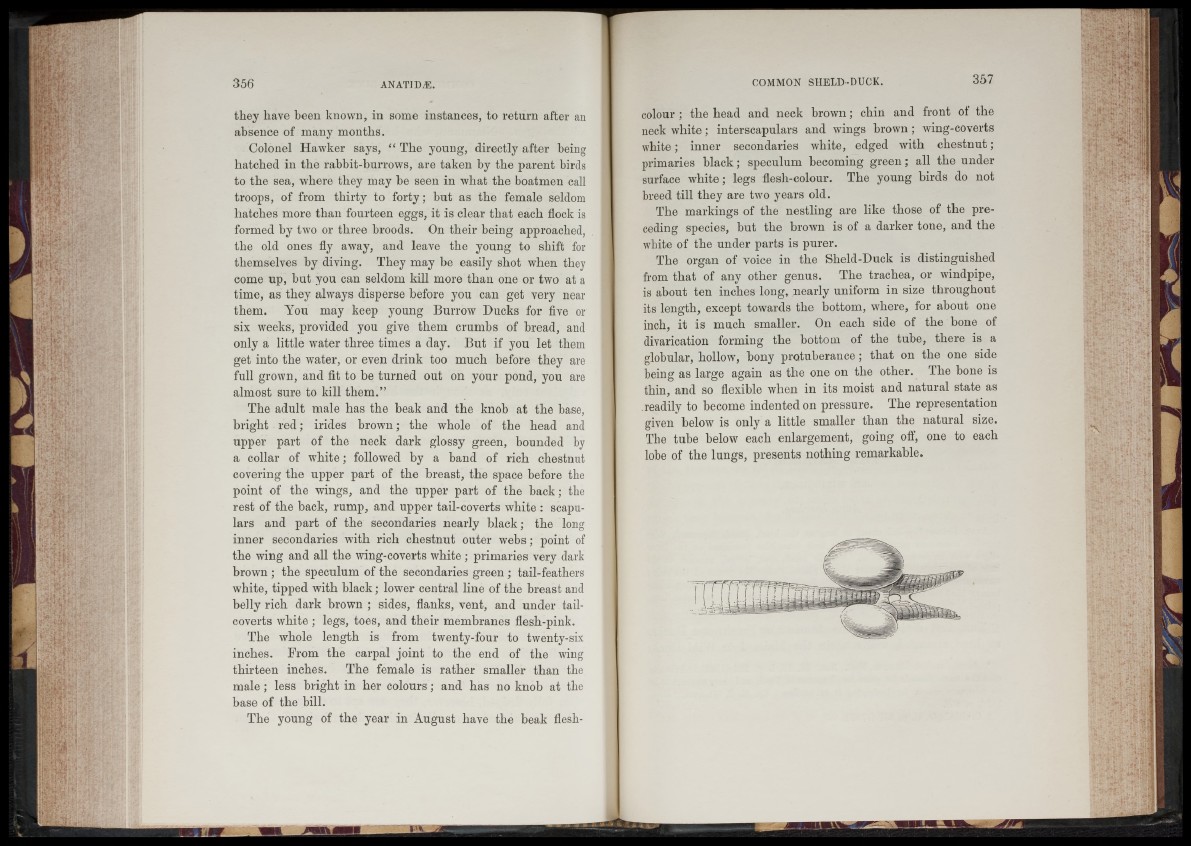
they have been known, in some instances, to return after an
absence of many months.
Colonel Hawker says, “ The young, directly after being
batched in the rabbit-burrows, are taken by the parent birds
to the sea, where they may be seen in wliat the boatmen call
troops, of from thirty to forty; but as the female seldom
batches more than fourteen eggs, it is clear that each flock is
formed by two or three broods. On their being approached,
the old ones fly away, and leave the young to shift for
themselves by diving. They may be easily shot when they
come up, but you can seldom kill more than one or two at a
time, as they always disperse before you can get very near
them. You may keep young Burrow Ducks for five or
six weeks, provided you give them crumbs of bread, and
only a little water three times a day. But if you let them
get into the water, or even drink too much before they are
full grown, and fit to be turned out on your pond, you are
almost sure to kill them.”
The adult male has the beak and the knob at the base,
bright red; irides brown; the whole of the head and
upper part of the neck dark glossy green, bounded by
a collar of white; followed by a band of rich chestnut
covering the upper part of the breast, the space before the
point of the wings, and the upper part of the back; the
rest of the back, rump, and upper tail-coverts white : scapulars
and part of the secondaries nearly black; the long
inner secondaries with rich chestnut outer webs; point of
the wing and all the wing-coverts white; primaries very dark
brown ; the speculum of the secondaries green ; tail-feathers
white, tipped with black; lower central line of the breast and
belly rich dark brown ; sides, flanks, vent, and under tail-
coverts white ; legs, toes, and their membranes flesh-pink.
The whole length is from twenty-four to twenty-six
inches. From the carpal joint to the end of the wing
thirteen inches. The female is rather smaller than the
male ; less bright in her colours; and has no knob at the
base of the bill.
The young of the year in August have the beak fleslicolour
; the head and neck brown; chin and front of the
neck white; interscapulars and wings brown ; wing-coverts
white; inner secondaries white, edged with chestnut ;
primaries black; speculum becoming green; all the under
surface white; legs flesh-colour. The young birds do not
breed till they are two years old.
The markings of the nestling are like those of the preceding
species, but the brown is of a darker tone, and the
white of the under parts is purer.
The organ of voice in the Sheld-Duck is distinguished
from that of any other genus. The trachea, or windpipe,
is about ten inches long, nearly uniform in size throughout
its length, except towards the bottom, where, for about one
inch, it is much smaller. On each side of the bone of
divarication forming the bottom of the tube, there is a
globular, hollow, bony protuberance; that on the one side
being as large again as the one on the other. The bone is
thin, and so flexible when in its moist and natural state as
readily to become indented on pressure. The representation
given below is only a little smaller than the natural size.
The tube below each enlargement, going off, one to each
lobe of the lungs, presents nothing remarkable.